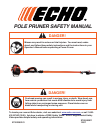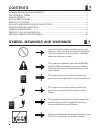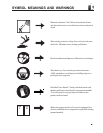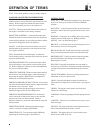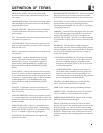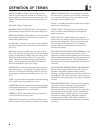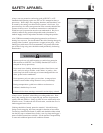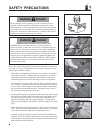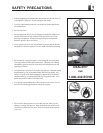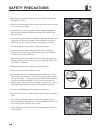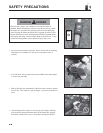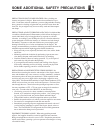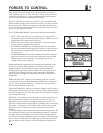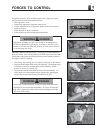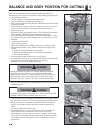
44
44
4
DEFINITION OF TERMS
UNIT - Power head, handles, cutting assembly and pole.
GASOLINE AND ELECTRIC POWERED TERMS
CHOKE LEVER - The engine control attached to the
carburetor that is used to enrich the fuel mixture for cold
starting. Refer to Operator’s Manual for more details
about correct position and use of the choke lever.
CLUTCH - The mechanism that transmits the rotation of
the engine’s crankshaft to the cutting assembly.
DIELECTRIC MATERIAL - A material that reduces the
likelihood of shock or electrocution from non-intentional
contact during operation by providing protection against
current flow through the unit to the operator.
GAUGE - A term that is used to describe the size of wire
required when using extension cords with electric units
over specific distances.
GFCI - Ground Fault Circuit Interrupter. An electrical
circuit breaking device which provides protection against
electrical shock hazards.
IGNITION/STOP SWITCH - An electrical switch which
allows the engine to start and run, and turns the engine
off. Refer to Operator’s Manual to learn and understand
the stop and start procedure.
THROTTLE TRIGGER - The device that controls the fuel
and air flow to the gasoline engine, either increasing or
decreasing the engine’s RPM. Refer to the Operator’s
Manual for an illustrated description.
THROTTLE TRIGGER LOCKOUT LEVER - A lever on the
top of the throttle handle which must be depressed before
the throttle can be activated. When
the operator releases the throttle trigger lockout lever,
the throttle trigger will lock in the idle position.
THROTTLE TRIGGER/STOP SWITCH - An electrical
switch which allows the electric motor to start and run,
and turns the motor off when released. Refer to
Operator’s Manual to learn and understand the stop and
start procedure.
THROTTLING BACK - Releasing the throttle trigger
to allow a decrease in engine speed (RPM).
THROTTLING UP - To increase the engine’s RPM by
depressing the throttle trigger to desired level.
GENERAL TERMS
ANSI Z87.1 - The established standard for eye protection
devices set forth by the American National Standards
Institute.
BALLISTIC - A special material used in protection devices
designed to reduce the risk of penetration from saw chain
contact.
BINDING - Closing the cut or shifting the wood, possibly
trapping the saw blade in the cut. Binding includes
pinching. (Also, see PINCH on page 6.)
BRANCH - A secondary shoot or stem arising from one of
the main axes of a tree or woody plant.
BRANCH COLLAR - Trunk tissue that forms around the
base of a branch between the main stem and the branch.
BRUSHING OUT - Cutting or otherwise removing under-
growth and brush in the cutting area and along the
planned path of retreat.
BUCKING - Generally the standard cross cuts made to
section a log or felled tree. Variations include overbucking
(cutting from top down) and underbucking (from under-
side).
CHAIN TENSIONER - The device which permits precise
adjustment of the saw chain tension.
CHAPS - Specially designed leg protection which can
reduce the risk of injury due to contact with a moving saw
chain.
CHOKE - The engine control used to enrich the fuel
mixture for cold starting.
CLEARING - Removing undergrowth and saplings from an
area.
CLOSURE - The process of woundwood covering a cut or
other tree injury.
CROTCH - The angle formed at the attachment between a
branch and another branch, leader, or trunk.
CROWN - The upper portion of a tree from the lowest
branch on the trunk to the top.



